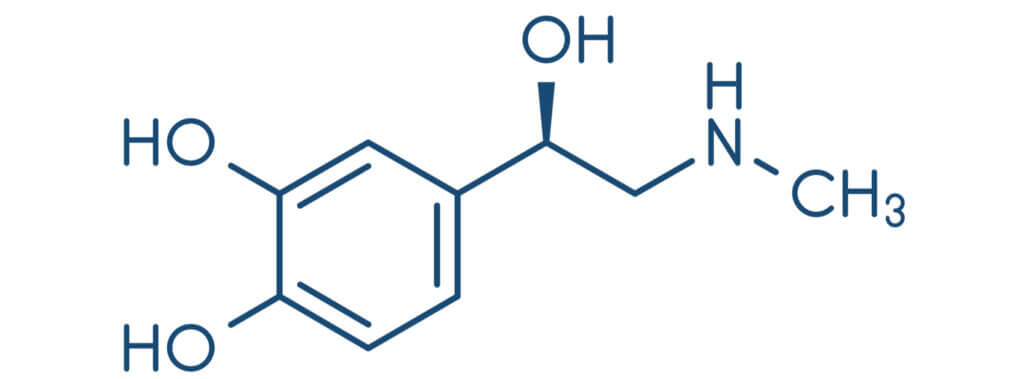The Purpose of Adrenaline


Escrito y verificado por el biólogo Samuel Antonio Sánchez Amador
Adrenaline, also known as epinephrine, is a hormone and neurotransmitter that occurs naturally in the adrenal glands, located above the kidneys. It’s the substance most associated with high levels of stress and fear. The purpose of adrenaline is to increase survival responses in situations of alarm.
We’re talking about a hormone of an intricate nature with multiple effects at the physiological level. In addition, epinephrine is a drug, as it’s used as an emergency treatment in patients with severe allergic reactions.
The chemical structure of adrenaline
Adrenaline or epinephrine is, from a chemical point of view, a catecholamine and a monoamine. Let’s see what these terms mean:
- Catecholamine: A hormone that’s released into the bloodstream. Apart from adrenaline, in this group, we can find noradrenaline and dopamine. Catecholamines are produced in the adrenal glands and at nerve endings.
- Monoamine: A neurotransmitter that contains an amino group—derived from ammonia—that’s connected to an aromatic ring, a type of cyclic organic compound, by two carbon bonds (-CH2-CH2-).
The chemical formula of adrenaline is as follows:
C₉H₁₃NO₃
This means that this molecule is made up of carbon, hydrogen, nitrogen, and oxygen. Due to the elements that compose it, we can affirm that we’re dealing with an organic substance.
According to the International Union of Pure and Applied Chemistry (IUPAC) the more technical name for adrenaline is the following: (R)-4-[1-hydroxy) (methylamino) ethyl]benzene-1,2- diol.
With these two terms and the relevant chemical formulation, we’ve defined the nature of adrenaline. It’s difficult to imagine the three-dimensional structure of such a complex hormone, but portals like Pubchem show us its 3D shape in detail.

How is adrenaline synthesized?
It should be noted that this hormone is synthesized based on the amino acids —basic components of proteins— phenylalanine and tyrosine. The first of the two is considered an essential amino acid that we must ingest in the diet, as we can’t synthesize it ourselves. On the other hand, tyrosine isn’t essential, as it’s created from phenylalanine itself.
As we’ve already said, adrenaline is produced in the adrenal glands, structures weighing about four grams located on the upper pole of both kidneys. These glands contain two distinguishable endocrine organs: The adrenal cortex and the adrenal medulla.
It’s the second that’s of interest to us, as, according to bibliographical sources, it’s responsible for secreting catecholamines into the bloodstream. In this organ, more than 80% of the catecholamine content corresponds to adrenaline, which will be released at specific times to exert effects on different organs. The remaining 20% concentration corresponds to norepinephrine.
We’ll present a series of relevant data on the synthesis of adrenaline:
- Catecholamines are formed from tyrosine. This, in turn, can come from the diet or be formed from phenylalanine within the body.
- This conversion process is summarized in four different stages: Hydroxylation, decarboxylation, another hydroxylation, and a methylation. These steps are mediated by specialized enzymes.
- After its formation, the adrenaline is transported to the granular vesicles, places where it’s stored.
Secretion
Adrenaline is released from the granule vesicles by exocytosis in the presence of the neurotransmitter acetylcholine. This is released in response to a specific stimulus, in this case, in the face of motivational events that require attention.
Of note, once in the blood, the overall lifetime of circulating acetylcholine is about 10 to 100 seconds. Although it may seem little, this is more than enough time for these hormones to perform the functions that characterize them.
The functions of adrenaline
Adrenaline is commonly associated with situations of fear and stress, as it prepares the body for an event that requires maximum attention and speed. At the physiological level, this translates into various changes:
- Raises blood pressure: The blood vessels that flow into the most important organs widen to receive more blood, while the smallest ones narrow, as they’re not essential.
- Dilates the pupils: This happens so that the individual can see better and be more aware of the environment around them.
- Expands the airways: The dilation of the airways translates into faster and more efficient breathing. This allows the subject to oxygenate the blood more and thus perform better. In the face of escape mechanisms or long runs, this mechanism is essential.
- Participates in the fight or flight reaction: It increases the desire to confront and the feeling of euphoria.
- Accelerates the heart rate: The more blood is pumped by the heart, the more oxygen and nutrients will reach the organs and muscles.
- It stops intestinal movement: This prevents untimely physiological needs and an energy expenditure that, at the moment of the threat, the body can’t afford.
- Mobilizes glycogen stores: The most used fuel in cellular respiration is glucose, which is stored as glycogen in the liver. Its release allows it to be obtained quickly so that tissue cells can use it promptly.
In general, we can summarize all these functions in a single concept: Preparing the individual for a fighting situation in which their integrity may be compromised. This is a clear evolutionary adaptation, as in the short term, this injection of energy marks the difference between life and death in a natural environment.
The medical uses of adrenaline
In addition to being an excellent provider of immediate coping mechanisms, adrenaline also has medical uses. According to the Spanish Society of Clinical Immunology, the main therapeutic purpose of this hormone is to prevent anaphylaxis.
Fighting anaphylaxis
Anaphylaxis is defined as a severe allergic reaction that can put the patient’s integrity at risk. As indicated by the Mayo Clinic, it can occur a few seconds or minutes after exposure to an agent to which the individual is allergic.
This clinical picture is characterized by a drop in blood pressure, skin reactions, and constriction of the airways, among many other symptoms. As we’ve said, adrenaline has the purpose of dilating the airways, making it the ideal drug of choice in this situation.
The adrenaline injection comes as a device pre-filled with a solution containing the hormone —at a concentration of 1:10,000—, which can be injected under the skin or into the muscle. People with severe allergies should always carry this device with them, as it’s the only way to deal with anaphylaxis effectively.
It should be noted that, unfortunately, epinephrine injections can have certain side effects. The National Library of Medicine of the United States shows us a few. Among them, we find the following:
- Nausea, vomiting, and sweating
- Nervousness, anxiety, and restlessness
- Weakness
- Headache
- Pale skin
- Uncontrollable tremor of some part of the body

A possible solution to cardiac arrest
Several studies indicate that adrenaline is effective in resuscitating the heart in cardiac arrest and helps patients enough to leave the hospital and return home. Unfortunately, there has been no evidence that drugs based on adrenaline serve the purpose of improving survival with a good neurological outcome.
Therefore, epinephrine may be key to resuscitating the heart in cardiac arrest, but it also increases the overall likelihood of death or debilitating brain damage.
Treatment for laryngitis
Other bibliographical sources show that some studies have shown that nebulized adrenaline improves the clinical picture of patients with moderate or severe laryngitis in about 10 to 30 minutes. This is because, in summary, the hormone causes relaxation of the bronchial smooth muscle.
In addition, contraindications to treatment are minimal. Although the patient’s heart rate may increase somewhat as a side effect of the administration, the possible adverse symptoms are far less relevant than the solutions.
A hormone full of utilities
This is a hormone and neurotransmitter involved in responses to stress, fear, tension, and the presence of threats. Adrenaline serves the purpose of preparing us to fight or flee, allocating all possible resources to the muscles and the development of the senses so that they work efficiently and quickly.
Beyond this, epinephrine is also used in the medical field: It’s the only solution to anaphylactic shock, it’s used to combat pharyngitis, and it’s also contemplated in cardiac arrest. Of course, this is a fascinating substance from a biological and pharmacological point of view.
Adrenaline, also known as epinephrine, is a hormone and neurotransmitter that occurs naturally in the adrenal glands, located above the kidneys. It’s the substance most associated with high levels of stress and fear. The purpose of adrenaline is to increase survival responses in situations of alarm.
We’re talking about a hormone of an intricate nature with multiple effects at the physiological level. In addition, epinephrine is a drug, as it’s used as an emergency treatment in patients with severe allergic reactions.
The chemical structure of adrenaline
Adrenaline or epinephrine is, from a chemical point of view, a catecholamine and a monoamine. Let’s see what these terms mean:
- Catecholamine: A hormone that’s released into the bloodstream. Apart from adrenaline, in this group, we can find noradrenaline and dopamine. Catecholamines are produced in the adrenal glands and at nerve endings.
- Monoamine: A neurotransmitter that contains an amino group—derived from ammonia—that’s connected to an aromatic ring, a type of cyclic organic compound, by two carbon bonds (-CH2-CH2-).
The chemical formula of adrenaline is as follows:
C₉H₁₃NO₃
This means that this molecule is made up of carbon, hydrogen, nitrogen, and oxygen. Due to the elements that compose it, we can affirm that we’re dealing with an organic substance.
According to the International Union of Pure and Applied Chemistry (IUPAC) the more technical name for adrenaline is the following: (R)-4-[1-hydroxy) (methylamino) ethyl]benzene-1,2- diol.
With these two terms and the relevant chemical formulation, we’ve defined the nature of adrenaline. It’s difficult to imagine the three-dimensional structure of such a complex hormone, but portals like Pubchem show us its 3D shape in detail.

How is adrenaline synthesized?
It should be noted that this hormone is synthesized based on the amino acids —basic components of proteins— phenylalanine and tyrosine. The first of the two is considered an essential amino acid that we must ingest in the diet, as we can’t synthesize it ourselves. On the other hand, tyrosine isn’t essential, as it’s created from phenylalanine itself.
As we’ve already said, adrenaline is produced in the adrenal glands, structures weighing about four grams located on the upper pole of both kidneys. These glands contain two distinguishable endocrine organs: The adrenal cortex and the adrenal medulla.
It’s the second that’s of interest to us, as, according to bibliographical sources, it’s responsible for secreting catecholamines into the bloodstream. In this organ, more than 80% of the catecholamine content corresponds to adrenaline, which will be released at specific times to exert effects on different organs. The remaining 20% concentration corresponds to norepinephrine.
We’ll present a series of relevant data on the synthesis of adrenaline:
- Catecholamines are formed from tyrosine. This, in turn, can come from the diet or be formed from phenylalanine within the body.
- This conversion process is summarized in four different stages: Hydroxylation, decarboxylation, another hydroxylation, and a methylation. These steps are mediated by specialized enzymes.
- After its formation, the adrenaline is transported to the granular vesicles, places where it’s stored.
Secretion
Adrenaline is released from the granule vesicles by exocytosis in the presence of the neurotransmitter acetylcholine. This is released in response to a specific stimulus, in this case, in the face of motivational events that require attention.
Of note, once in the blood, the overall lifetime of circulating acetylcholine is about 10 to 100 seconds. Although it may seem little, this is more than enough time for these hormones to perform the functions that characterize them.
The functions of adrenaline
Adrenaline is commonly associated with situations of fear and stress, as it prepares the body for an event that requires maximum attention and speed. At the physiological level, this translates into various changes:
- Raises blood pressure: The blood vessels that flow into the most important organs widen to receive more blood, while the smallest ones narrow, as they’re not essential.
- Dilates the pupils: This happens so that the individual can see better and be more aware of the environment around them.
- Expands the airways: The dilation of the airways translates into faster and more efficient breathing. This allows the subject to oxygenate the blood more and thus perform better. In the face of escape mechanisms or long runs, this mechanism is essential.
- Participates in the fight or flight reaction: It increases the desire to confront and the feeling of euphoria.
- Accelerates the heart rate: The more blood is pumped by the heart, the more oxygen and nutrients will reach the organs and muscles.
- It stops intestinal movement: This prevents untimely physiological needs and an energy expenditure that, at the moment of the threat, the body can’t afford.
- Mobilizes glycogen stores: The most used fuel in cellular respiration is glucose, which is stored as glycogen in the liver. Its release allows it to be obtained quickly so that tissue cells can use it promptly.
In general, we can summarize all these functions in a single concept: Preparing the individual for a fighting situation in which their integrity may be compromised. This is a clear evolutionary adaptation, as in the short term, this injection of energy marks the difference between life and death in a natural environment.
The medical uses of adrenaline
In addition to being an excellent provider of immediate coping mechanisms, adrenaline also has medical uses. According to the Spanish Society of Clinical Immunology, the main therapeutic purpose of this hormone is to prevent anaphylaxis.
Fighting anaphylaxis
Anaphylaxis is defined as a severe allergic reaction that can put the patient’s integrity at risk. As indicated by the Mayo Clinic, it can occur a few seconds or minutes after exposure to an agent to which the individual is allergic.
This clinical picture is characterized by a drop in blood pressure, skin reactions, and constriction of the airways, among many other symptoms. As we’ve said, adrenaline has the purpose of dilating the airways, making it the ideal drug of choice in this situation.
The adrenaline injection comes as a device pre-filled with a solution containing the hormone —at a concentration of 1:10,000—, which can be injected under the skin or into the muscle. People with severe allergies should always carry this device with them, as it’s the only way to deal with anaphylaxis effectively.
It should be noted that, unfortunately, epinephrine injections can have certain side effects. The National Library of Medicine of the United States shows us a few. Among them, we find the following:
- Nausea, vomiting, and sweating
- Nervousness, anxiety, and restlessness
- Weakness
- Headache
- Pale skin
- Uncontrollable tremor of some part of the body

A possible solution to cardiac arrest
Several studies indicate that adrenaline is effective in resuscitating the heart in cardiac arrest and helps patients enough to leave the hospital and return home. Unfortunately, there has been no evidence that drugs based on adrenaline serve the purpose of improving survival with a good neurological outcome.
Therefore, epinephrine may be key to resuscitating the heart in cardiac arrest, but it also increases the overall likelihood of death or debilitating brain damage.
Treatment for laryngitis
Other bibliographical sources show that some studies have shown that nebulized adrenaline improves the clinical picture of patients with moderate or severe laryngitis in about 10 to 30 minutes. This is because, in summary, the hormone causes relaxation of the bronchial smooth muscle.
In addition, contraindications to treatment are minimal. Although the patient’s heart rate may increase somewhat as a side effect of the administration, the possible adverse symptoms are far less relevant than the solutions.
A hormone full of utilities
This is a hormone and neurotransmitter involved in responses to stress, fear, tension, and the presence of threats. Adrenaline serves the purpose of preparing us to fight or flee, allocating all possible resources to the muscles and the development of the senses so that they work efficiently and quickly.
Beyond this, epinephrine is also used in the medical field: It’s the only solution to anaphylactic shock, it’s used to combat pharyngitis, and it’s also contemplated in cardiac arrest. Of course, this is a fascinating substance from a biological and pharmacological point of view.
- Epinephrine, Pubchem. Recogido a 8 de noviembre en https://pubchem.ncbi.nlm.nih.gov/compound/Epinephrine#section=3D-Conformer&fullscreen=true
- Hormonas catecolamínicas adrenales, Cátedra de bioquímica: facultad de medicina (2010). Recogido a 8 de noviembre en https://med.unne.edu.ar/sitio/multimedia/imagenes/ckfinder/files/files/Carrera-Medicina/BIOQUIMICA/catecolaminas.pdf
- ¿Qué es la adrenalina y para qué se utiliza? Sociedad española de Inmunología Clínica. Recogido a 8 de noviembre en http://www.seicap.es/es/-qu%C3%A9-es-la-adrenalina-y-para-qu%C3%A9-se-utiliza-_81091
- Anafilaxia, mayoclinic. Recogido a 8 de noviembre en https://www.mayoclinic.org/es-es/diseases-conditions/anaphylaxis/symptoms-causes/syc-20351468#:~:text=La%20anafilaxia%20es%20una%20reacci%C3%B3n,la%20picadura%20de%20una%20abeja.
- Inyección de epinefrina, medlineplus.gov. Recogido a 8 de noviembre en https://medlineplus.gov/spanish/druginfo/meds/a603002-es.html
- Sienra-Monge, Juan José Luis, et al. “Anafilaxia en niños y adultos: prevención, diagnóstico y tratamiento.” Revista Conamed 24.3 (2019): 107-164.
- El Pediatra de Atención Primaria y la laringitis aguda – Crup, GRUPO DE VÍAS RESPIRATORIAS. Recogido a 8 de noviembre en https://www.aepap.org/sites/default/files/documento/archivos-adjuntos/laringitis-2018.pdf#:~:text=En%20la%20laringitis%20moderada%20administrar,pautas%20de%20adrenalina%20son%20correctas.
Este texto se ofrece únicamente con propósitos informativos y no reemplaza la consulta con un profesional. Ante dudas, consulta a tu especialista.







